Yellow spots in grass are such an eye sore that can bring the perfectionist out in any homeowner.
Several factors can cause chlorosis or yellowing of grass, starting from soil conditions down to your dog’s pee. Learn how to restore the yellow patches in your lawn through the things that cause them.
Like other plants, lawn grass is also affected by environmental stress, chemical burns, and heat. They can manifest through pale-looking blades, bald patches, and yellow leaves.
The key to solving these lawn problems is to get to the root cause and learn how you can help your grass become more resilient and support its growth.
What Causes Yellow Spots in Grass?
Every type of grass, whether it’s a warm season or a cool season type, requires a specific environment, care, and weed-killer concoction to thrive. What puts them in one category is their common weakness against the following plant stresses that leads to yellow spots in grass.
Nutrient Deficiency
Iron chlorosis and nitrogen deficiency are the usual culprits in turfgrass discoloration. These two conditions cause yellowing grass but they require different treatments.
Iron chlorosis happens when the soil is too alkaline with a soil pH range of 7 and above and the roots fail to absorb enough iron from the soil. Nitrogen deficiency often occurs when most of the nutrients in the soil leach out due to watering and rain.
Most homeowners make big mistakes by treating nitrogen-deficient lawns with more iron while iron-deficient lawns with nitrogen fertilizers.
To avoid such costly mistakes here are some of the differences to tell if the yellowing is due to iron chlorosis or nitrogen deficiency:
(1) Yellowing pattern: The yellow spots in the grass with iron chlorosis starts at the tip between the veins of the leaves. On the other hand, lawns suffering from nitrogen deficiency have yellow spots that start at the base of the leaves.
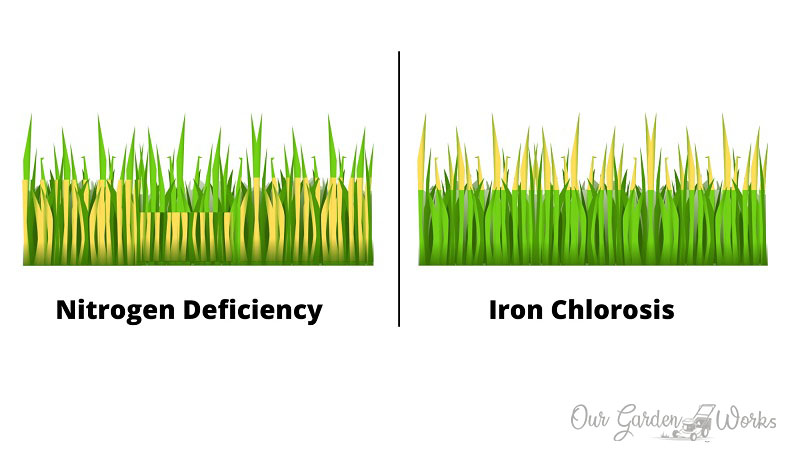
(2) Progression: Iron chlorosis will initially look like yellow-green patches on the lawn. As the iron chlorosis gets worse, the leaves will turn grayish-white. Nitrogen-deficient grass starts from having yellow pots at the base of the blades that spread throughout the leaves.
Another cause of nutrient deficiency in lawns is a high soil pH level and drowning roots due to overwatering.
When the soil is too acidic or alkaline, the grassroots will fail to absorb nutrients from the soil. Factors like rain and organic matter decay can alter soil acidity or alkalinity over time which breaks the proper nutrient absorption of grass.
How to treat lawn nutrient deficiency?
Fertilizing the lawn may be the first solution that you may think of when dealing with nutrient deficiency. However, the approach should be more strategic than that.
You’ll be wasting a lot of effort and money on fertilizers if the soil is not on the right pH level for the grass variety that you have.
Here are the specific treatments that you can try based on the cause of nutrient deficiency:
(1) Iron deficiency: Check for signs of iron chlorosis like the pattern on the leaves and the soil pH level. A lawn soil deficient in iron is often too alkaline which inhibits the ability of the roots to take up iron.
The ideal soil pH level for most grass varieties is 6.5-7. If the pH level is at 7 and above, you need to acidify the soil using:
- Iron fertilizers.
- Sulfur.
- Soil acidifiers/amendments.
It takes 3 months to see the results after supplying your lawn with iron and acidifying the soil.
(2) Nitrogen deficiency: Check if the grass has yellow spots from the base of the blades to confirm if you are dealing with nitrogen problems. Once confirmed, you can use any of the following:
- Ammonium-based lawn fertilizers (Quick-fix).
- Aged manure.
- Coffee grounds.
(3) Acidic soil: If the soil pH level is below 6.5, then the soil is most likely too acidic and the roots can’t absorb soil nutrients.
You can use agricultural lime to change the soil pH. We discussed the use of lime in lawns and its benefits in a separate post here.
Drought Stress
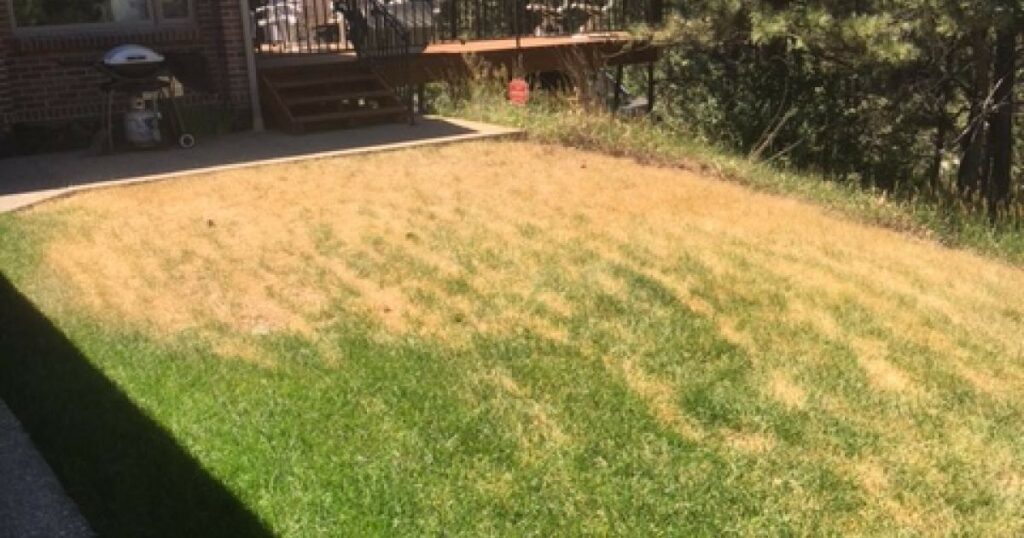
Lawn grass is resilient under the scorching sun as long as it gets the watering it needs.
It has its self-preservation measure wherein it cuts off the supply of nutrients to unessential parts of the plant when experiencing drought stress. In turn, the blades of grass turn yellow and eventually wilt.
The obvious sign that grass is experiencing drought stress is when the blades become yellow with brown tips and the texture becomes crunchy. At this point, the grass is still alive but tries to survive by entering dormancy.
When leaves dry up, they lose chlorophyll and turn brown. When the grass is rehydrated again, the plant will not turn brown leaves green. Instead, it leaves the dried ones and grows new green leaves.
How to treat lawn drought stress?
During dry spells and hot summers, increase the frequency of your watering and ensure that they are deeply watered in the morning.
Water your lawn at least 3 times a week and let the water soak the soil up to one inch deep. Lessen the watering if there is rainfall within the week.
Over-fertilization
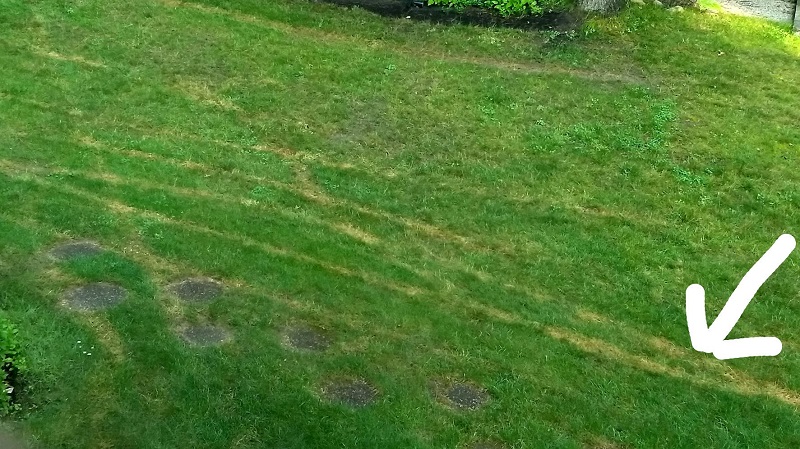
Anything too much is bad, even with plant food for plants. Overfertilization causes an accumulation of salts in the soil which causes chemical burns on the roots of plants, resulting in yellow leaves.
Aside from excessive fertilizer application, soil compaction is also another factor that may consequently cause overfertilization.
Fertilizers that are not absorbed by the grassroots can either stay in the soil or leach into the ground through watering.
The signs of over-fertilization often show as yellow and browning of leaves. However, you’ll easily know that the problem is due to overfertilization if the yellow spots in the grass have a specific pattern.
How to treat an over-fertilized lawn?
The good news with an overfertilized lawn is you can still revive it as long as the grass is still yellow or brown. However, if the leaves started to get crusty that look like it’s fried, they’re beyond saving.
As soon as you notice the yellowing blades of grass, water the area generously to flush or leach the excess salts in the soil. Water the affected area every day for seven consecutive days.
After a few weeks, you’ll notice new leaves growing. If the grass failed to survive, you may need to re-seed the damaged areas.
Pest Damage
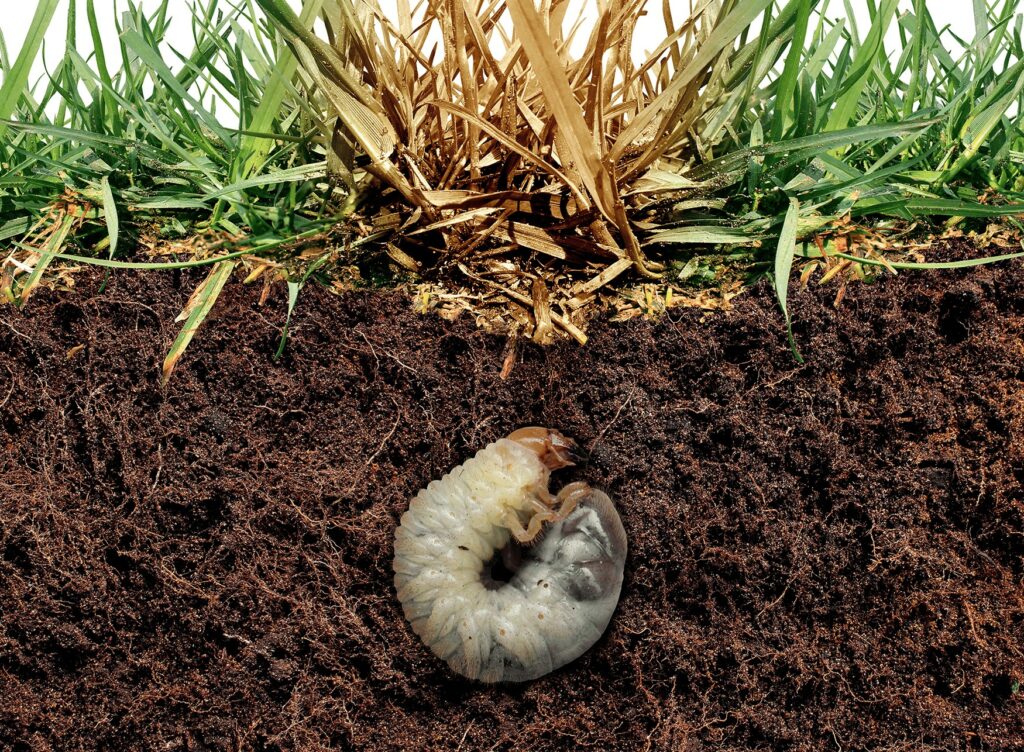
If the soil is in good condition and the weather is good, two possible pests might be causing the yellow spots on your lawn.
These include white grubs and chinch bugs. They slowly feed on the blades and roots of the grass which are unnoticeable in the first few weeks.
Visible damage will only occur the damage becomes worse and manifests as yellow spots to brown and dead patches on the lawn.
Here’s how you can identify them:
(1) White grubs: These infamous C-shaped worms are the larvae of Japanese and scarab beetles. They feed on grassroots which manifests as yellow or brown spots in the early stage of damage. Telltale signs that your lawn is infested with white grubs are as follows:
- The grass becomes spongey and you can lift it off the ground like a mat.
- Birds, skunks, and worm-eating wildlife frequently visit our lawn.
(2) Chinch bugs: These small six-legged sap-sucking insects feeds on the grass and secretes a substance that inhibits and blocks the ability of leaves to absorb water. Its damage to grass is often mistaken as drought stress due to brown and yellow patches.
To know the difference between drought stress and chinch bug infestation check the base of the grass, you will find adult chinch bugs hiding from the scorching sun.
Before watering your lawn on suspicion that it is experiencing drought stress, check for tiny black insects at the base of the grass first. Doing so will help you save on water and use a better method to manage chinch bugs.
How to manage lawn pests?
Before you apply anything on the lawn make sure that you are dealing with pests.
- For white grubs, cut a plate-sized turf on the damaged area and lift it to see if any grubs are hiding underneath.
- For chinch bugs, inspect the base of the grass to see some adults hiding from plain sight.
Once you confirm the infestation, you can start with pest management. Pest control methods include:
(1) Chemical control: The fastest way to deal with heavy infestations is using chemical pesticides with active ingredients imidacloprid for grubs and bifenthrin for chinch bugs.
Here are some of the highly recommended brands of lawn professionals in dealing with these infestations:
Grub:
- Bayer Advanced Complete Insect Killer for Soil & Turf
- Scotts GrubEx1
- Bonide (BND95349) – Insect Control Systemic Granules
Chinch bugs:
- Compare-N-Save Concentrate Indoor and Outdoor Insect Control
- Bifen IT
- Sevin 100530123 GardenTech Insect Killer Concentrate
(2) Biological pest control: Milky spore contains a bacterium that helps control grubs through ingestion. It is a harmless soil-borne disease that will help manage and prevent future grub infestation on your lawn.
It comes in a powder form that you can apply in spring and summer when grubs are actively feeding on your lawn.
The commonly used milky spore in the market is St. Gabriel Organics Milky Spore Powder used with its specialized dispenser.
(3) Homemade pest control: If you’re not a fan of using chemicals on your lawn, you may use a mixture of dish soap and water for pest control.
Mix 2 tablespoons of dish soap to 2 gallons of water and apply it to the yellow spots in the grass. For heavy infestations, you may add another tablespoon of dish soap into the solution
Pro Tip: According to Michigan State University, you should not use pesticides with the following active ingredients for grubs because they will not reach the first 1 to 3 inches of soil to kill them:
- Bifenthrin
- Lambda-cyhalothrin
- Gamma-cyhalothrin
- Deltamethrin
- Cyfluthrin
- Permethrin
Dog Urine
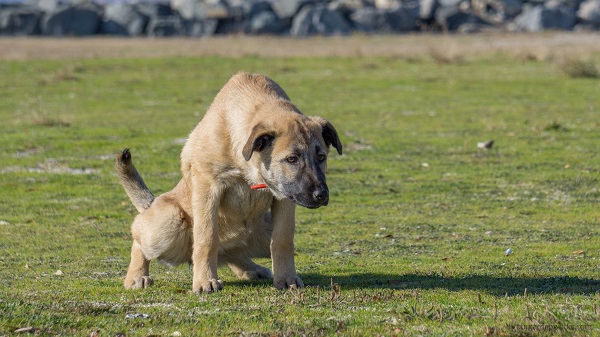
Regardless of breed and gender, dog urine can cause yellow spots in grass or turf the same way overfertilization damages the lawn. Dog urine contains sats and nitrogen compounds that burn the grass.
Pets are often allowed to roam around the property for their daily exercise and to keep them from making a mess indoors. So, the only option is to either train them to pee in a specific spot away from the lawn or flush the lawn as soon as you saw them pee.
How to flush dog urine on the lawn?
As soon as you let your dogs out on the lawn, bring a hose or a pail of water to pour in the spots where they peed. You must water the spot thoroughly to leach the urine and get rid of the excess salts in the soil.
If you’re not sure where and when your dogs get a call of nature, it’s best to turn your sprinkler every afternoon to flush the whole lawn.
Frequently Asked Questions (FAQs)
How do you fix yellow spots in St Augustine grass?
Nutrient deficiency, herbicide injury, and fungal disease are the common cause of yellow spots in St. Augustine grass. Out of all the grass varieties, St. Augustine is particularly sensitive to weed killers.
To fix the yellow spots, the first thing that you should check is the soil pH level before applying lawn fertilizer. If the result is more than 7 you have to add more soil acidifier and if it is below 6.5, you have to lime your lawn to balance the soil pH.
You should also test a weed killer in a tiny spot on your lawn to see how the grass will react to it. Weed killer brands often fail to include the grass varieties that can get injured using their formula. So, better check the labels first or test them in a small patch to be sure.
Once the soil pH is at the right level, you may start fertilizing the soil with nitrogen fertilizers or add manure.
Is yellow grass dead?
Yellow grass is still alive and can still recover. The grass turns yellow when it is under stress and only supplies its energy to the essential parts of the plant. It sacrifices some of its leaves to survive until it regains access to plant food or water.
The grass is dead if the leaves turn brown and become flakey or crusty.
Final Thoughts
Yellow spots in grass are hard to determine if you are not familiar with how the soil structure, climate, and nutrients affect plant health.
We hope this post helped you better understand lawn maintenance so you can fix bald and unsightly patches without professional help.
Let us know in the comments what is the culprit behind the yellow spots on your lawn!
Also, don’t forget to share this post with your friends to help them achieve a uniformly green and lush lawn this summer.
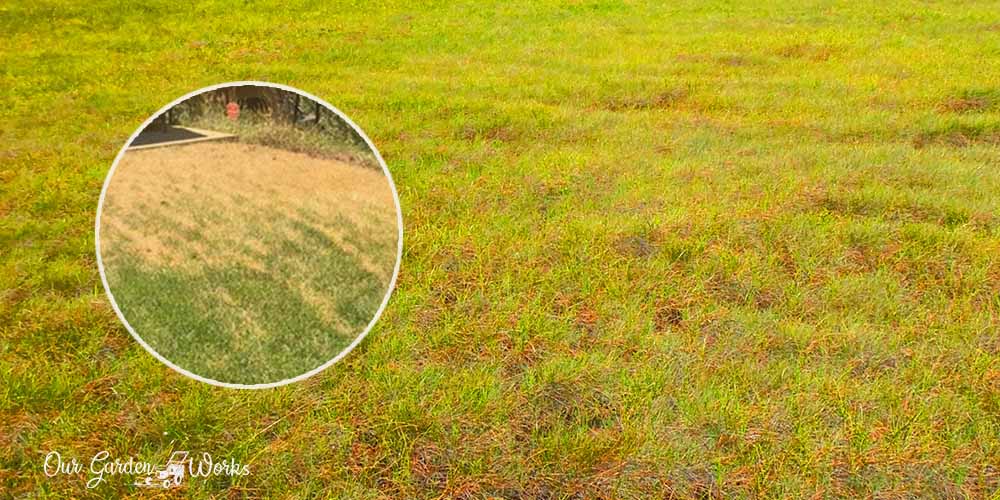
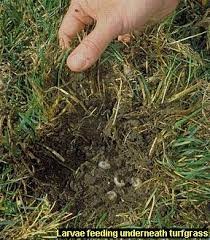
Another cause of yellow spots is grass spot is close to a road and a car is parked there with the motor running, the car exhaust damages the grass.